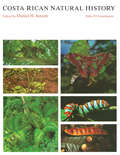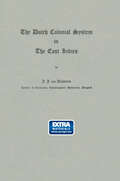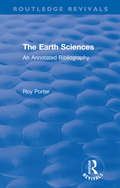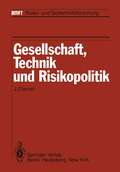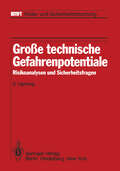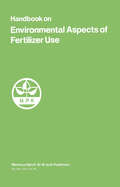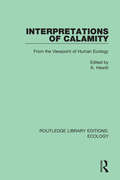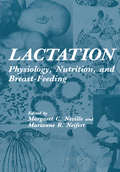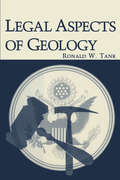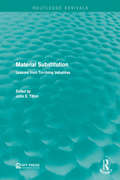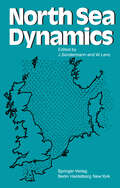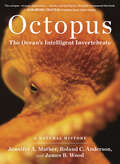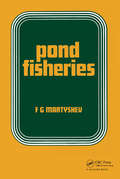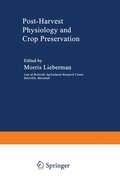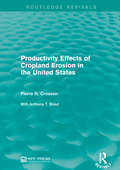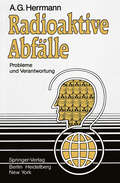- Table View
- List View
Costa Rican Natural History
by Daniel H. JanzenThis volume is a synthesis of existing knowledge about the flora and fauna of Costa Rica. The major portion of the book consists of detailed accounts of agricultural species, vegetation, amphibians, reptiles, mammals, birds, and insects. "This is an extraordinary, virtually unique work. . . . The tremendous amount of original, previously unpublished, firsthand information is remarkable."—Peter H. Raven, Director, Missouri Botanical Garden "An essential resource for anyone interested in tropical biology. . . . It can be used both as an encyclopedia—a source of facts on specific organisms—and as a source of ideas and generalizations about tropical ecology."—Alan P. Smith, Ecology
The Earth Sciences: An Annotated Bibliography (Routledge Revivals)
by Roy PorterOriginally published in 1983, The Earth Sciences: An Annotated Bibliography is a compact and thematically organized guide that provides comprehensive access to themes and areas of study in the earth sciences. The bibliography is not exhaustive but provides a detailed and critical index to the most important literature in the field. The book’s core focus is geology and examines the subject broadly, covering everything from glaciology, geomorphology, natural history and palaeontology, to oceanography, mapping, stratigraphy and evolution. The book provides detailed essays for each bibliographical chapter on the state of each field of research and the literature compiled for each bibliography will go as far back as around 1700 and contains a wide range of sources from across the world. This book will be of interest to academics and students of natural history, geology, and environmental sciences alike.
The Earth Sciences: An Annotated Bibliography (Routledge Revivals)
by Roy PorterOriginally published in 1983, The Earth Sciences: An Annotated Bibliography is a compact and thematically organized guide that provides comprehensive access to themes and areas of study in the earth sciences. The bibliography is not exhaustive but provides a detailed and critical index to the most important literature in the field. The book’s core focus is geology and examines the subject broadly, covering everything from glaciology, geomorphology, natural history and palaeontology, to oceanography, mapping, stratigraphy and evolution. The book provides detailed essays for each bibliographical chapter on the state of each field of research and the literature compiled for each bibliography will go as far back as around 1700 and contains a wide range of sources from across the world. This book will be of interest to academics and students of natural history, geology, and environmental sciences alike.
Genetic Engineering of Plants: An Agricultural Perspective (Basic Life Sciences #26)
by Tsune Kosuge Carole P. Meredith Alexander Hollaender Claire M. WilsonWilliam C. Taylor Department of Genetics University of California Berkeley, California 94720 It is evident by now that there is a great deal of interest in exploiting the new technologies to genetically engineer new forms of plants. A purpose of this meeting is to assess the possibilities. The papers that follow are concerned with the analysis of single genes or small gene families. We will read about genes found within the nucleus, plastids, and bacteria which are responsible for agri culturally important traits. Given that these genes can be isolated by recombinant DNA techniques, there are two possible strategies for plant engineering. One involves isolating a gene from a cultivated plant, changing it in a specific way and then inserting it back into the same plant where it produces an altered gene product. An example might be changing the amino acid composition of a seed pro tein so as to make the seed a more efficient food source. A second strategy is to isolate a gene from one species and transfer it to another species where it produces a desirable feature. An example might be the transfer of a gene which encodes a more efficient pho tosynthetic enzyme from a wild relative into a cultivated species. There are three technical hurdles which must be overcome for either strategy to work. The gene of interest must be physically isolated.
Große technische Gefahrenpotentiale: Risikoanalysen und Sicherheitsfragen (BMFT - Risiko- und Sicherheitsforschung)
by S. HartwigHandbook on Environmental Aspects of Fertilizer Use
by International Potash International Potash Institute (IPI)Interpretations of Calamity: From the Viewpoint of Human Ecology (Routledge Library Editions: Ecology #4)
by K. HewittOriginally published in 1983, Interpretations of Calamity provides a provocative critique of the ‘dominant view’ of research into natural hazards. Throughout the world, there are now many people professionally engaged in the mitigation and control of risks & hazards, and the impact of continuing economic development will ensure that they are fully employed. There is a wealth of perspectives in the book, including weather and wheat yields in the Soviet Union and Canada, an historical view of underdevelopment and hazards in Ireland and the impact of a response to drought in southern Africa, the Sahel and the Great Plains of the USA. The book reflects the major themes of hazards in the context of economic development and social change. Most of the case studies are from the rural and agriculture scene. This book provides a unique view of the vital importance of food production and of the considerable, and sometimes calamitous, impact that frost, flood, storm and drought have on the wellbeing of millions of people and on the stability of the international economic system.
Interpretations of Calamity: From the Viewpoint of Human Ecology (Routledge Library Editions: Ecology #4)
by K. HewittOriginally published in 1983, Interpretations of Calamity provides a provocative critique of the ‘dominant view’ of research into natural hazards. Throughout the world, there are now many people professionally engaged in the mitigation and control of risks & hazards, and the impact of continuing economic development will ensure that they are fully employed. There is a wealth of perspectives in the book, including weather and wheat yields in the Soviet Union and Canada, an historical view of underdevelopment and hazards in Ireland and the impact of a response to drought in southern Africa, the Sahel and the Great Plains of the USA. The book reflects the major themes of hazards in the context of economic development and social change. Most of the case studies are from the rural and agriculture scene. This book provides a unique view of the vital importance of food production and of the considerable, and sometimes calamitous, impact that frost, flood, storm and drought have on the wellbeing of millions of people and on the stability of the international economic system.
Lactation: Physiology, Nutrition, and Breast-Feeding
by Margaret NevilleThis book had its genesIs In the frustrations of the editors in locating authoritative, up-to-date material for an interdisciplinary graduate course in mammary gland biology, lactation, and breast-feeding. As we turned to the original literature several reasons for the dearth of usable material became clear: (1) In the areas of mammary gland biology and physiology, particularly as they relate to the human, reviews simply have not kept up with current research, which has in the last two decades provided tremendous insight into the mechanisms of milk secretion and its control. (2) The lack of interest in human milk as infant food inhibited researchers until very recently from investigating human lactation. (3) Much of the relevant clinical information remains anecdotal with little scientific basis. In this book we have tried to present the fundamentals of mammary gland physiology at the organismic and cellular levels in a form readily understood by physicians, scientists, and other professionals. This basic information is accompanied by authoritative reviews of the nutritional and immunological properties of human milk and by clinically relevant chapters designed to help health care professionals deal with the medical problems of the breast-feeding mother and her infant. We have strived in these chapters for up-to-date, authoritative, but readable accounts. In so far as possible we have avoided areas where much of our understanding rests on speculation. In the clinical domain this was not always possible because of a lack of solid, scientific information about breast-feeding.
Late- and Postglacial Oscillations of Glaciers: Glacial and Periglacial Forms
by H. Schroeder-LanzThis volume represents the proceedings from a colloquium held in West Germany in 1980 on late and postglacial oscillations of glaciers. The main texts are in German (13), English (8) and French (5) but all have abstracts in the three languages and all the figure captions are similarly translated.
Late- and Postglacial Oscillations of Glaciers: Glacial and Periglacial Forms
by H. Schroeder-LanzThis volume represents the proceedings from a colloquium held in West Germany in 1980 on late and postglacial oscillations of glaciers. The main texts are in German (13), English (8) and French (5) but all have abstracts in the three languages and all the figure captions are similarly translated.
Legal Aspects of Geology
by Ronald W. TankThis treatise is an outgrowth of a series of seminars and tutorials on selected legal aspects of geology that were offered to several generations of undergraduate students at Lawrence University. The offerings were in response to a keen interest in how the law and legal institutions relate to the professional geologist. Much of the student interest was undoubtedly sparked by the legal controversies as sociated with the "environmental movement" that became so active during the 1970s and continues today to look to the law for the resolution of conflicting goals. Other students were interested in the role allocated to law by society in general, or were simply curious about law as a profession. Existing published material did not meet my needs, and I had to rely on "handouts" summarizing legal principles, reported appellate cases, and guest lectures from the county bar association. The more formally prepared course materials were edited by practicing attorneys and scholars in academia who encouraged me to seek a publisher who might make the materials available to a broader audience-an audience that might include not only students of the law but also the professional geologist, geological engineers, planners, policy makers, and attorneys, whether in industry, government, education, or private practice, who want to know more about the relationship between law and geology.
Material Substitution: Lessons from Tin-Using Industries (Routledge Revivals)
by John E. TiltonSubstitution has long been a common remedy for materials shortages. This study, originally published in 1983, uses tin to examine how and why substitution takes place. To provide insights into the tin industry and the practice of substitution, the case studies in this title examine three tin-using industries—beverage containers, solder, and tin chemical stabilisers. Overall, the contributors to this volume raise fundamental questions concerning the techniques for both short- and long-term forecasts of materials requirements in the industrial sector. This title will be of particular interest to students of Environmental Science.
Material Substitution: Lessons from Tin-Using Industries (Routledge Revivals)
by John E. TitltonSubstitution has long been a common remedy for materials shortages. This study, originally published in 1983, uses tin to examine how and why substitution takes place. To provide insights into the tin industry and the practice of substitution, the case studies in this title examine three tin-using industries—beverage containers, solder, and tin chemical stabilisers. Overall, the contributors to this volume raise fundamental questions concerning the techniques for both short- and long-term forecasts of materials requirements in the industrial sector. This title will be of particular interest to students of Environmental Science.
North Sea Dynamics
by Professor Dr. Jürgen Sündermann Diplom-Ozeanograph Walter LenzThis volume contains the proceedings of the International Sym posium on North Sea Dynamics which was held in Hamburg, August 31 - September 4, 1981. More than 150 participants from 10 coun tries were present at the Symposium. Of the 58 lectures given, 45 are printed in this book. The manuscripts were reviewed by an international advisory board. The main goal of the organizers was to bring together as many active researchers as possible in this very general field of North Sea dynarnics, transcending the boundaries of the countries and the various disciplines involved, in order to discuss the main problems and future trends. In the ten years since the last comparable meeting in Aviemore, Scotland, several large interna tional experiments (JONSDAP '73 and '76, JONSWAP '73, '75 and '77, MARSEN '79) and new developments in modelling promised a rewarding exchange of ideas. In addition to the physical disci plines, biologists and geologists are increasingly able to pre sent quantitative analyses.
Octopus: The Ocean's Intelligent Invertebrate
by Jennifer A. Mather Roland C. Anderson James B. WoodThe visually arresting and often misunderstood octopus has long captured popular imagination. With an alien appearance and an uncanny intellect, this exceptional sea creature has inspired fear in famous lore and legends—from the giant octopus attack in 20,000 Leagues Under the Sea to Ursula the sea witch in The Little Mermaid. Yet its true nature is more wondrous still. After decades of research, the authors reveal a sensitive, curious, and playful animal with remarkable intelligence, an ability to defend itself with camouflage and jet propulsion, an intricate nervous system, and advanced problem-solving abilities. In this beautifully photographed book, three leading marine biologists bring readers face to face with these amazingly complex animals that have fascinated scientists for decades. From the molluscan ancestry of today&’s octopus to its ingenious anatomy, amazing mating and predatory behaviors, and other-worldly relatives, the authors take readers through the astounding life cycle, uncovering the details of distinctive octopus personalities. With personal narratives, underwater research, stunning closeup photography, and thoughtful guidance for keeping octopuses in captivity, Octopus is the first comprehensive natural history of this smart denizen of the sea.
Oxygen Transport to Tissue—IV (Advances in Experimental Medicine and Biology #159)
by Haim I. BicherThe International Society on OXygen Transport to Tissue (ISO'IT) has canpleted nine years as a society since its first fonnal meeting at Charleston-Clanson, South Carolina, United States of America in 1973. Prior to this time an active group of scientists and engineers rret in w::>rkshop environrrents, on a periodic basis, around the w::>rld. Meetings are ncM on an annual basis, alternating between Europe and the United States. The international gatherings include scientists and engineers in a variety of fields. ISOIT has produced a stable forum for the exchange of info:rmation on the rnicroenvirornnent of living cells, ranging fran the utilization of mathematics and engineering, through physiology and radiobiology, to clinical applications. The proceedings of these meetings have been codified into six books, four of them published by Plenum Press in its prestigious Advances in Experimental Medicine and Biology series. This volume, together with the next two volumes that will follCJV.l the meetings in Dortmund, Gennany in 1982 and in Ruston, Louisiana in 1983 will provide further chapters in the history of this fascinating field of knCJV.lledge. OUr thanks are given to all the participants and contributors to the Detroit meeting. We hope that the strength of the society will grow in caning years, and that our contribution will eventually be felt in :inproving the treatment of the sick, and in enhancing the thought processes of the intellectual.
Pond Fisheries
by F. MartyshevA comprehensive study of pond fisheries. Topics include the organisation and construction of fish ponds, production processes in fish farms for warmwater carp and cold-water trout, and irrigation networks and reservoirs constructed for multipurpose exploitation.
Pond Fisheries
by F. MartyshevA comprehensive study of pond fisheries. Topics include the organisation and construction of fish ponds, production processes in fish farms for warmwater carp and cold-water trout, and irrigation networks and reservoirs constructed for multipurpose exploitation.
Post-Harvest Physiology and Crop Preservation (Nato Science Series A: #46)
by Morris LiebermanEmphasis in agricultural research for many years has concen trated on crop production. This emphasis has become more important in recent years with the realization that the population worldwide is outstripping the food supply. There is, however, another side to increasing the availability of the food supply. This simply involves preservation of the harvested crop·for human consumption. The losses incurred in harvesting, handling, transportation, storage and marketing crops have become a greater problem as the distance from the farm to the ultimate consumer increases. In the Western world where modern transportation, storage facilities, and marketing technology are widely used, post-harvest technology requires a large input of energy which increases costs considerably. There fore, losses are more significant and the ability to provide fresh fruits and vegetables, out of season, at reasonable costs will depend on reduced post-harvest losses throughout the marketing chain from the farm gate to the ultimate consumer. The reduction in post-harvest losses depends on proper use of current technology and further developments derived from a broad spectrum of scientific disciplines. Biochemistry, plant physiology, plant pathology, horticulture, agronomy, physics, engineering and agricultural economics, all provide knowledge which has been useful and will be useful in the future for improving post-harvest technol ogy and crop preservation. This volume records the Proceedings of the NATO Advanced Study Institute on Post-Harvest Physiology and Crop Preservation, held at Sounion, Greece, April 28 - May 8, 1981.
Productivity Effects of Cropland Erosion in the United States (Routledge Revivals)
by Pierre R. CrossonIn the 1970’s, agriculture in the United States seemed to be booming. With an extra demand for crops, extra acres were taken on to increase production which was predicted to increase further with an ever-growing population. However, concerns were beginning to be raised over the adequacy of land for crops as potential croplands began to be converted into urban areas as well as the effects of soil erosion decreasing the quality of these croplands. Originally published in 1983, this study investigates the threats to crop productivity in the U.S. with a focus on human-made problems. This title will be of interest to students of environmental studies.
Productivity Effects of Cropland Erosion in the United States (Routledge Revivals)
by Pierre R. CrossonIn the 1970’s, agriculture in the United States seemed to be booming. With an extra demand for crops, extra acres were taken on to increase production which was predicted to increase further with an ever-growing population. However, concerns were beginning to be raised over the adequacy of land for crops as potential croplands began to be converted into urban areas as well as the effects of soil erosion decreasing the quality of these croplands. Originally published in 1983, this study investigates the threats to crop productivity in the U.S. with a focus on human-made problems. This title will be of interest to students of environmental studies.
